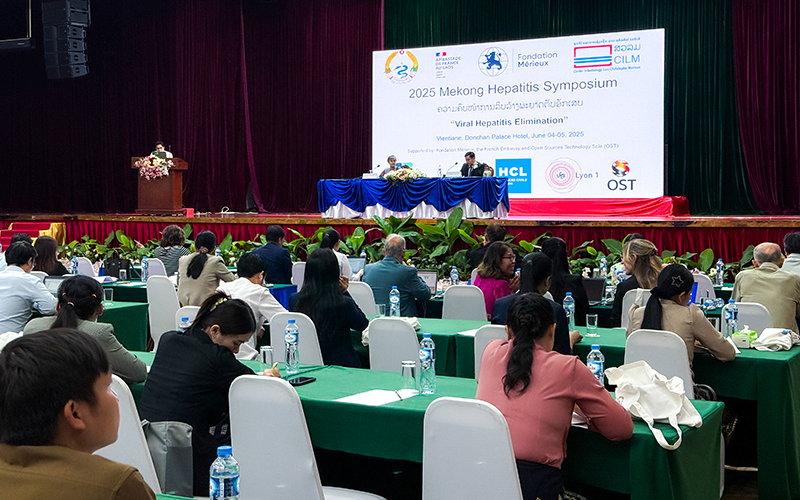
Participants at the 2025 Mekong Symposium on Hepatitis Elimination in Vientiane
After years of virtual gatherings due to the COVID-19 pandemic, the symposium brought together clinicians, researchers, and public health experts committed to eliminating viral hepatitis as a public health threat.
Originally launched in 2012 under the auspices of the Lao Ministry of Health, the symposium has grown into a collaborative effort involving Cambodia, China, Thailand, Vietnam, Australia, Myanmar, and India. The CILM, the Mérieux Foundation, Open Sources Technology Sole (OST), and partners such as French Embassy in Lao PDR, Chiang Mai University, INSERM, and Institut Pasteur du Cambodge continue to play pivotal roles in organizing the event.
“Bringing the symposium back to Vientiane marks a symbolic and practical milestone in the regional fight against chronic viral hepatitis,” says Dr. Rattanaxay of Fondation Mérieux. “It’s about reconnecting our network and advancing the WHO 2030 goals together—with science, solidarity, and field-based action.”
A Region Under Pressure
Lao PDR, the symposium’s host, faces a particularly acute hepatitis challenge. With HBsAg[1] prevalence rates between 4% and 6% and the highest incidence of liver cancer worldwide, the country exemplifies the urgent need for concerted efforts to detect, treat, and prevent hepatitis.
Against this backdrop, the 2025 symposium agenda is ambitious and tightly focused. Over four thematic sessions, participants will explore the latest WHO recommendations, epidemiological updates, and breakthroughs in diagnostics and treatment—from maternal prophylaxis trials and molecular diagnostics to the integration of hepatitis care in harm reduction programs and moving towards hepatitis elimination.
“There is progress, but also persistent gaps,” notes Dr. Paboriboune of CILM. “One of our missions this year is to spotlight local innovations and encourage scalable strategies—from remote rural areas to national health systems.”
Dialogue and Discovery
The symposium opened with speeches from the Lao Ministry of Health and the French Embassy, setting the stage for a series of expert-led sessions. Pr. Christian Trépo and Pr. Paul Dény explored the natural history of the Hepatitis B virus and prospects for its cure, while Dr. Caroline Scholtès provided insights into the diagnosis and virological follow-up of hepatitis B and Delta, as well as diagnostic approaches for hepatitis C. Experts from the Great Mekong Subregion countries also exchanged best practices in providing diagnosis and treatment to the community including high risk population.
In keeping with its strong research orientation, this edition also showcased recent studies from across the region: The iTAP-2 trial results on infant immunization in Lao PDR and Thailand; Epidemiological findings from the Teulakao Project in Lao PDR; Innovative case detection models from Cambodia and Vietnam; and Groundbreaking CRISPR-Cas diagnostics under development in Thailand.
“We need to move from fragmented efforts to integrated care models—especially for populations most at risk, like people who inject drugs,” explained Dr. Soe Thet Lwin from Myanmar’s Asian Harm Reduction Network.
The symposium’s final sessions centered on adolescent and pediatric hepatitis C treatment, retreatment strategies, and long-term complications like cirrhosis and liver cancer.
Looking Forward
As the event concluded, the Scientific Committee issued recommendations and renewed its call for cross-border collaboration.
As the region recommits to the WHO 2030 elimination targets, the 2025 Mekong Hepatitis Symposium reaffirms the importance of local leadership, regional unity, and evidence-based innovation—all of which are vital to turning the tide on viral hepatitis.
[1] hepatitis B surface antigen (HBsAg) is a protein on the surface of the hepatitis B virus (HBV), and its presence in the blood indicates that a person is infected with HBV — either as an acute or chronic carrier.
